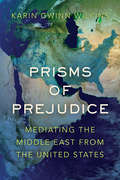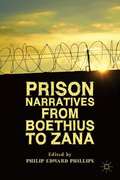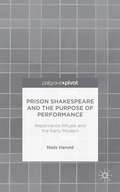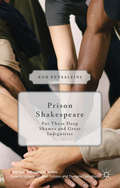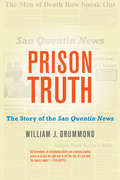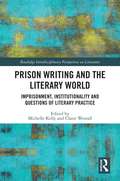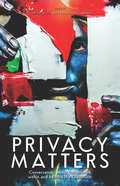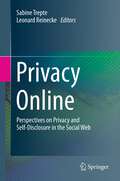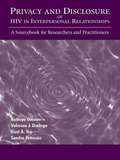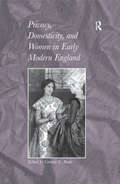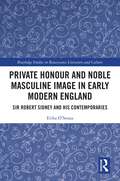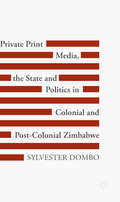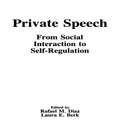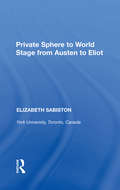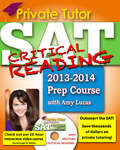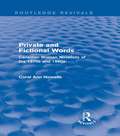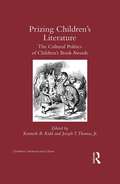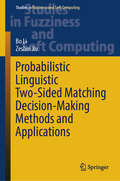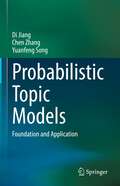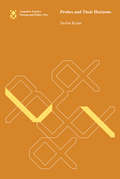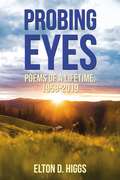- Table View
- List View
Prisms of Prejudice: Mediating the Middle East from the United States
by Karin Gwinn WilkinsMedia do not reflect: media refract. In the United States, established and enduring prisms of prejudice about the projected "Middle East" are mediated through popular culture, broadcast news, government mission statements and official maps. This mediation serves to assert political boundaries and construct the United States as heroic against a villainous or victimized Middle East. These problematic maps and narratives are persistent over time and prevalent across genre, with clear consequences evidenced by the rise in discriminatory sentiments in the US population and experiences of harm in US Arab and Muslim communities. Exploring a wide range of media, Karin Gwinn Wilkins illuminates the shape and scope of these narratives and explores ways to counter these prisms of prejudice through informed and engaged strategic intervention in critical communication literacy.
Prison Narratives from Boethius to Zana
by Philip Edward PhillipsPrison Narratives from Boethius to Zana critically examines selected works of writers, from the sixth century to the twenty-first century, who were imprisoned for their beliefs. Chapters explore figures' lives, provide close analyses of their works, and offer contextualization of their prison writings.
Prison Shakespeare and the Purpose of Performance: Repentance Rituals and the Early Modern
by Niels HeroldOver the last decade a number of prison theatre programs have developed to rehabilitate inmates by having them perform Shakespearean adaptations. While twentieth and twenty-first century ideas about theatre as therapy, political resistance, and popular education hold sway for many programs, this book focuses on how prison theatre today reveals certain elements of the early modern theatre that were themselves responses to cataclysmic changes in theological doctrine and religious practice. Herold reads the Shakespearean theatre at once historically and forward ("presentising"). He examines the precise dramaturgical and ideological elements of this historical theatre that are today conducive to the remarkable rehabilitative success of prison theatre programs like Shakespeare Behind Bars.
Prison Shakespeare: For These Deep Shames and Great Indignities (Palgrave Shakespeare Studies)
by Rob PensalfiniThis book explores the development of the global phenomenon of Prison Shakespeare, from its emergence in the 1980s to the present day. It provides a succinct history of the phenomenon and its spread before going on to explore one case study the Queensland Shakespeare Ensemble's (Australia) Shakespeare Prison Project in detail. The book then analyses the phenomenon from a number of perspectives, and evaluates a number of claims made about the outcomes of such programs, particularly as they relate to offender health and behaviour. Unlike previous works on the topic, which are largely individual case studies, this book focuses not only on Prison Shakespeare's impact on the prisoners who directly participate, but also on prison culture and on broader social attitudes towards both prisoners and Shakespeare.
Prison Truth: The Story of the San Quentin News
by William J. DrummondSan Quentin State Prison, California’s oldest prison and the nation’s largest, is notorious for once holding America’s most dangerous prisoners. But in 2008, the Bastille-by-the-Bay became a beacon for rehabilitation through the prisoner-run newspaper the San Quentin News.Prison Truth tells the story of how prisoners, many serving life terms, transformed the prison climate from what Johnny Cash called a living hell to an environment that fostered positive change in inmates’ lives. Award-winning journalist William J. Drummond takes us behind bars, introducing us to Arnulfo García, the visionary prisoner who led the revival of the newspaper. Drummond describes how the San Quentin News, after a twenty-year shutdown, was recalled to life under an enlightened warden and the small group of local retired newspaper veterans serving as advisers, which Drummond joined in 2012. Sharing how officials cautiously and often unwittingly allowed the newspaper to tell the stories of the incarcerated, Prison Truth illustrates the power of prison media to humanize the experiences of people inside penitentiary walls and to forge alliances with social justice networks seeking reform.
Prison Writing and the Literary World: Imprisonment, Institutionality and Questions of Literary Practice (Routledge Interdisciplinary Perspectives on Literature)
by Michelle Kelly and Claire WestallPrison Writing and the Literary World tackles international prison writingand writing about imprisonment in relation to questions of literary representationand formal aesthetics, the “value” or “values” of literature,textual censorship and circulation, institutional networks and literary-criticalmethodologies. It offers scholarly essays exploring prison writingin relation to wartime internment, political imprisonment, resistance andindependence creation, regimes of terror, and personal narratives of developmentand awakening that grapple with race, class and gender. Cuttingacross geospatial divides while drawing on nation- and region-specific expertise,it asks readers to connect the questions, examples and challengesarising from prison writing and writing about imprisonment within theUK and the USA, but also across continental Europe, Stalinist Russia, theAmericas, Africa and the Middle East. It also includes critical reflectionpieces from authors, editors, educators and theatre practitioners with experienceof the fraught, testing and potentially inspiring links between prisonand the literary world.
Privacy Matters: Conversations about Surveillance within and beyond the Classroom
by Estee Beck Les HutchinsonPrivacy Matters examines how communications and writing educators, administrators, technological resource coordinators, and scholars can address the ways surveillance and privacy affect student and faculty composing, configure identity formation, and subvert the surveillance state. This collection offers practical analyses of surveillance and privacy as they occur within classrooms and communities. Organized by themes—surveillance and classrooms, surveillance and bodies, surveillance and culture—Privacy Matters provides writing, rhetoric, and communication scholars and teachers with specific approaches, methods, inquiries, and examinations into the impact tracking and monitoring has upon people’s habits, bodies, and lived experiences. While each chapter contributes a new perspective in the discipline and beyond, Privacy Matters affirms that these analyses remain inconclusive. This collection is a call for scholars, researchers, activists, and educators within rhetoric and composition to continue the scholarly conversation because privacy matters to all of us. Contributors: Christina Cedillo, Jenae Cohn, Dànielle Nicole DeVoss, Dustin Edwards, Norah Fahim, Ann Hill Duin, Gavin P. Johnson, John Peterson, Santos Ramos, Colleen A. Reilly, Jennifer Roth Miller, Jason Tham, Stephanie Vie
Privacy Online
by Sabine Trepte Leonard ReineckeCommunications and personal information that are posted online are usually accessible to a vast number of people. Yet when personal data exist online, they may be searched, reproduced and mined by advertisers, merchants, service providers or even stalkers. Many users know what may happen to their information, while at the same time they act as though their data are private or intimate. They expect their privacy will not be infringed while they willingly share personal information with the world via social network sites, blogs, and in online communities. The chapters collected by Trepte and Reinecke address questions arising from this disparity that has often been referred to as the privacy paradox. Works by renowned researchers from various disciplines including psychology, communication, sociology, and information science, offer new theoretical models on the functioning of online intimacy and public accessibility, and propose novel ideas on the how and why of online privacy. The contributing authors offer intriguing solutions for some of the most pressing issues and problems in the field of online privacy. They investigate how users abandon privacy to enhance social capital and to generate different kinds of benefits. They argue that trust and authenticity characterize the uses of social network sites. They explore how privacy needs affect users' virtual identities. Ethical issues of privacy online are discussed as well as its gratifications and users' concerns. The contributors of this volume focus on the privacy needs and behaviors of a variety of different groups of social media users such as young adults, older users, and genders. They also examine privacy in the context of particular online services such as social network sites, mobile internet access, online journalism, blogs, and micro-blogs. In sum, this book offers researchers and students working on issues related to internet communication not only a thorough and up-to-date treatment of online privacy and the social web. It also presents a glimpse of the future by exploring emergent issues concerning new technological applications and by suggesting theory-based research agendas that can guide inquiry beyond the current forms of social technologies.
Privacy and Disclosure of Hiv in interpersonal Relationships: A Sourcebook for Researchers and Practitioners (Routledge Communication Series)
by Valerian J. Derlega Kathryn Greene Gust A. Yep Sandra PetronioAs the HIV epidemic enters its third decade, it remains one of the most pressing health issues of our time. Many aspects of the disease remain under-researched and inadequate attention has been given to the implications for the relationships and daily lives of those affected by HIV. Disclosing an HIV diagnosis remains a decision process fraught with difficulty and despite encouraging medical advances, an HIV diagnosis creates significant anxiety and distress about one's health, self-identity, and close relationships. This book provides an overarching view of existing research on privacy and disclosure while bringing together two significant areas: self-disclosure as a communication process and the social/relational consequences of HIV/AIDS. The unifying framework is communication privacy management and the focus of this volume is on private voluntary relational disclosure as opposed to forced or public disclosure. Utilizing numerous interviews with HIV patients and their families, the authors examine disclosure in a variety of social contexts, including relationships with intimate partners, families, friends, health workers, and coworkers. Of note are the examinations of predictors of willingness to disclose HIV infection, the message features of disclosure, and the consequences of both disclosure and non-disclosure. This volume, with its personal exercises and sources of additional information, offers an invaluable resource for individuals living with HIV and their significant others, as well as for professionals in the fields of health communication, social and health psychology, family therapy, clinical and counseling psychology, relationship research, infectious disease, and social service.
Privacy in the Age of Shakespeare
by Ronald HuebertFor at least a generation, scholars have asserted that privacy barely existed in the early modern era. The divide between the public and private was vague, they say, and the concept, if it was acknowledged, was rarely valued. In Privacy in the Age of Shakespeare, Ronald Huebert challenges these assumptions by marshalling evidence that it was in Shakespeare's time that the idea of privacy went from a marginal notion to a desirable quality.The era of transition begins with More's Utopia (1516), in which privacy is forbidden. It ends with Milton's Paradise Lost (1667), in which privacy is a good to be celebrated. In between come Shakespeare's plays, paintings by Titian and Vermeer, devotional manuals, autobiographical journals, and the poetry of George Herbert and Robert Herrick, all of which Huebert carefully analyses in order to illuminate the dynamic and emergent nature of early modern privacy.
Privacy, Domesticity, and Women in Early Modern England
by Corinne S. AbateThe ten essays in this collection explore the discrete yet overlapping female spaces of privacy and domesticity in early modern England. While other literary critics have focused their studies of female privacy on widows, witches, female recusants and criminals, the contributors to this collection propose that the early modern subculture of femaleness is more expansive and formative than is typically understood. They maintain that the subculture includes segregated, sometimes secluded, domestic places for primarily female activities like nursing, sewing, cooking, and caring for children and the sick. It also includes hidden psychological realms of privacy, organized by women's personal habits, around intimate friendships or kinship, and behind institutional powerlessness. The texts discussed in the volume include plays not only by Shakespeare but also Ford, Wroth, Marvell, Spenser and Cavendish, among others. Through the lens of literature, contributors consider the unstructured, fluid quality of much everyday female experience as well as the dimensions, symbols, and the ever-changing politics and culture of the household. They analyze the complex habits of female settings-the verbal, spatial, and affective strategies of early-modern women's culture, including private rituals, domestic practices, and erotic attachments-in order to provide a broader picture of female culture and of female authority. The authors argue-through a range of critical approaches that include feminist, historical, and psychoanalytic-that early modern women often transformed their confinement into something useful and necessary, creating protected and even sacred spaces with their own symbols and aesthetic.
Private Honour and Noble Masculine Image in Early Modern England: Sir Robert Sidney and His Contemporaries (Routledge Studies in Renaissance Literature and Culture)
by Erika D'SouzaRobert Sidney, the first Earl of Leicester (1563–1626), serves as an exemplar of an Elizabethan nobleman who had in his collection a body of work pertinent to the subject of masculine honour in the private realm. Understanding the nuances and evolution of the term private honour as it is represented in Sidney’s artefacts, as well as in the public discourse of the era, is the work and contribution of this book. The permeability between the private and public spheres led to an emergence of new forms of masculine representation. In a time when manhood was intertwined with militaristic qualities (such as courage, strength and fortitude), my investigation shows that in the domestic sphere, a gentler version of masculinity, encouraging humility, constancy and modesty, was fostered amongst the nobility. While worries of effeminacy certainly existed, there also was a strong discourse that encourage men to adopt so-called feminine virtues within the private sphere.
Private Print Media, the State and Politics in Colonial and Post-Colonial Zimbabwe
by Sylvester DomboThis book examines the role played by two popular private newspapers in the struggle for democracy in Zimbabwe, one case from colonial Rhodesia and the other from the post-colonial era. It argues that, operating under oppressive political regimes and in the dearth of credible opposition political parties or as a platform for opposition political parties, the African Daily News, between 1956-1964, and the Daily News, between 1999-2003, played an essential role in opening up spaces for political freedom in the country. Both newspapers were ultimately shut down by the respective government of the time. The newspapers allowed reading publics the opportunity to participate in politics by providing a daily analytical alternative, to that offered by the government and the state media, in relation to the respective political crises that unfolded in each of these periods. The book further examines both the information policies pursued by the different governments and the way these affected the functioning of private media in their quest to provide an "ideal" public sphere. It explores issues of ownership, funding and editorial policies in reference to each case and how these affected the production of news and issue coverage. It considers issues of class and geography in shaping public response. It also focuses on state reactions to the activities of these newspapers and how these, in turn, affected the activities of private media actors. Finally, it considers the cases together to consider the meanings of the closing down of these newspapers during the two eras under discussion and contributes to the debates about print media vis-#65533;-vis the new forms of media that have come to the fore.
Private Speech: From Social Interaction To Self-regulation
by Laura E. Berk Rafael M. DiazSince the publication of Vygotsky’s Thought and Language in the United States, a number of North American and European investigators have conducted systematic observations of children’s spontaneous private speech, giving substantial support to Vygotsky’s major hypotheses — particularly those regarding the social origins of higher psychological functions. However, there still remain many vital questions about the origins, significance, and functions of private speech: How can social and private speech be validly differentiated? What kinds of social interactions promote the use of private speech? What are the sources of individual differences in the use of private speech? This unique volume addresses these and many other important questions. Characterized by a strong emphasis on original data, it reports on systematic observations of spontaneous private speech in children and adults in both laboratory and naturalistic settings. In addition to its systematic analysis of common methodological problems in the field, the book contains the most comprehensive bibliography of the private speech literature currently available.
Private Sphere to World Stage from Austen to Eliot
by Elizabeth SabistonEmily Dickinson's poem, 'This is my letter to the World/ That never wrote to Me --', opens the Introduction, which focuses on the near-anonymity of nineteenth-century women novelists. Close readings of works by five British novelists Jane Austen, Charlotte and Emily Brontë, Elizabeth Gaskell, and George Eliot offer persuasive accounts of the ways in which women used stealth tactics to outmaneuver their detractors. Chapters examine the 'hidden manifesto' in Austen's works, whose imaginative heroines defend women's writing; the lasting impact of Jane Eyre, with its modest heroine who takes up the pen to tell her own story, even on male writers outside the English tradition; Cathy's testament as the 'ghost-text' of Wuthering Heights; and the shifting gender roles in Daniel Deronda, with its silenced heroine and androgynous hero. Though the focus is on British novelists, the author's discussion of the Anglo-American connections in the factory novels of Elizabeth Gaskell and the slavery writings of Harriet Beecher Stowe has particular relevance for its demonstration of how the move from the private to the public sphere enables and even compels the blurring of national and ethnic boundaries. What emerges is a compelling argument for the relevance of these novelists to the emergence in our own time of hitherto-silenced female voices around the globe.
Private Tutor - SAT Critical Reading 2013-2014 Prep Course
by Amy LucasThe purchase of this eBook includes an offer for a FREE DVD or Digital Download of 2 hours from our 20-hour SAT prep video course. Private Tutor SAT Critical Reading 2013-2014 Prep Course is a critically-praised, low cost alternative to the often unaffordable tutoring industry. Students can achieve the results of private tutoring at a fraction of the cost. This complete course covers all aspects of the SAT Critical Reading sections including Vocabulary, Sentence Completions, Reading Comprehension techniques, and the various types of Passages. Written by Amy Lucas, a Summa Cum Laude graduate of UCLA with fifteen years of experience as an SAT Master Tutor and Education Specialist. The School Library Journal Starred Review stated "Library collections serving high school students as well as homeschoolers seeking instruction, practice, and basic standardized test-taking tips for the Math SAT will find this series an essential purchase." The Library Journal stated, " Verdict: highly recommended for students taking the SATs." Reading book can be used alone or with the corresponding 5-hour DVD course. * Achieve the results of Private Tutoring at a fraction of the cost! * Basic Vocabulary and Sentence Completions * Types of Passages and Reading Comprehension Techniques * Which Answer Choices to avoid... and which ones to pick * Practice Drills with Answers and Explanations * Personal one-to-one approach from an experienced Master Tutor INCLUDES: * Vocabulary * Sentence Completions * Comprehension Fundamentals * Process of Elimination * Comprehension Techniques * Fiction Passage * Compare and Contrast * Short Passages * Extra Reading Comprehension Practice
Private and Fictional Words: Canadian Women Novelists of the 1970s and 1980s (Routledge Revivals)
by Coral Ann HowellsFirst published in 1987, this is an introductory study of the most widely read Canadian women novelists of the 1970s and 1980s. At its centre lies the question of how the search for a distinctive cultural identity relates to the need for a national cultural identity in the post-colonial era. Coral Ann Howells argues that Canadian women’s fiction throughout the period of study represents how the Canadian cultural identity exceeds its geographical limits, and those traditional structures of patriarchal authority need revision if women’s alternative views are to be taken into account. Including short biographical sketches and a complete list of the books published by the authors under discussion, writers examined include Margaret Atwood, Alice Munro, and Margaret Laurence.
Prizing Children's Literature: The Cultural Politics of Children’s Book Awards (Children's Literature and Culture)
by Kenneth B. Kidd Joseph T. Thomas Jr.Children's book awards have mushroomed since the early twentieth-century and especially since the 1960s, when literary prizing became a favored strategy for both commercial promotion and canon-making. There are over 300 awards for English-language titles alone, but despite the profound impact of children’s book awards, scholars have paid relatively little attention to them. This book is the first scholarly volume devoted to the analysis of Anglophone children's book awards in historical and cultural context. With attention to both political and aesthetic concerns, the book offers original and diverse scholarship on prizing practices and their consequences in Australia, Canada, and especially the United States. Contributors offer both case studies of particular awards and analysis of broader trends in literary evaluation and elevation, drawing on theoretical work on canonization and cultural capital. Sections interrogate the complex and often unconscious ideological work of prizing, the ongoing tension between formalist awards and so-called identity-based awards — all the more urgent in light of the "We Need Diverse Books" campaign — the ever-morphing forms and parameters of prizing, and scholarly practices of prizing. Among the many awards discussed are the Pura Belpré Medal, the Inky Awards, the Canada Governor General Literary Award, the Printz Award, the Best Animated Feature Oscar, the Phoenix Award, and the John Newbery Medal, giving due attention to prizes for fiction as well as for non-fiction, poetry, and film. This volume will interest scholars in literary and cultural studies, social history, book history, sociology, education, library and information science, and anyone concerned with children's literature.
Prizing Literature
by Gillian RobertsWhen Canadian authors win prestigious literary prizes, from the Governor General's Literary Award to the Man Booker Prize, they are celebrated not only for their achievements, but also for contributing to this country's cultural capital. Discussions about culture, national identity, and citizenship are particularly complicated when the honorees are immigrants, like Michael Ondaatje, Carol Shields, or Rohinton Mistry. Then there is the case of Yann Martel, who is identified both as Canadian and as rootlessly cosmopolitan. How have these writers' identities been recalibrated in order to claim them as 'representative' Canadians?Prizing Literature is the first extended study of contemporary award winning Canadian literature and the ways in which we celebrate its authors. Gillian Roberts uses theories of hospitality to examine how prize-winning authors are variously received and honoured depending on their citizenship and the extent to which they represent 'Canadianness.' Prizing Literature sheds light on popular and media understandings of what it means to be part of a multicultural nation.
Probabilistic Linguistic Two-Sided Matching Decision-Making Methods and Applications (Studies in Fuzziness and Soft Computing #436)
by Zeshui Xu Bo LiThis book tackles the intricacies of decision-making processes where alternatives stem from distinct, finite sets. Discover the cutting-edge in decision-making with our groundbreaking book on complex two-sided matching methods. Harnessing the power of probabilistic linguistic term sets, it introduces innovative methods that enhance matching efficiency and practicality. It addresses the pressing question of how to navigate and optimize in scenarios with multifaceted matching challenges, offering an exploration into the psychological perceptions of agents through consistency checks and pairwise comparisons. It delves into the unknowns of static matching with multiple attribute weights, extends its scope to multi-sided agent sets in complex matching, and introduces dynamic screening mechanisms to refine the matching process. This book is not just a theoretical exploration. It lays the groundwork for intelligent matching algorithms and group mechanisms, providing actionable insights for technical supply and demand allocation, emergency personnel dispatch, and multi-stage medical management scheme selection. The effectiveness of these methods is backed by comparative analyses and simulation experiments, proving their superiority in real-world applications. Embrace the future of decision-making with our book, a must-read for those seeking to master complex matching scenarios and unlock practical solutions.
Probabilistic Topic Models: Foundation and Application
by Chen Zhang Di Jiang Yuanfeng SongThis book introduces readers to the theoretical foundation and application of topic models. It provides readers with efficient means to learn about the technical principles underlying topic models. More concretely, it covers topics such as fundamental concepts, topic model structures, approximate inference algorithms, and a range of methods used to create high-quality topic models. In addition, this book illustrates the applications of topic models applied in real-world scenarios. Readers will be instructed on the means to select and apply suitable models for specific real-world tasks, providing this book with greater use for the industry. Finally, the book presents a catalog of the most important topic models from the literature over the past decades, which can be referenced and indexed by researchers and engineers in related fields. We hope this book can bridge the gap between academic research and industrial application and help topic models play an increasingly effective role in both academia and industry. This book offers a valuable reference guide for senior undergraduate students, graduate students, and researchers, covering the latest advances in topic models, and for industrial practitioners, sharing state-of-the-art solutions for topic-related applications. The book can also serve as a reference for job seekers preparing for interviews.
Probes and Their Horizons (Linguistic Inquiry Monographs #81)
by Stefan KeineA comprehensive theory of selective opacity effects—configurations in which syntactic domains are opaque to some processes but transparent to others—within a Minimalist framework.In this book, Stefan Keine investigates in detail “selective opacity”— configurations in which syntactic domains are opaque to some processes but transparent to others—and develops a comprehensive theory of these syntactic configurations within a contemporary Minimalist framework. Although such configurations have traditionally been analyzed in terms of restrictions on possible sequences of movement steps, Keine finds that analogous restrictions govern long-distance dependencies that do not involve movement. He argues that the phenomenon is more widespread and abstract than previously assumed. He proposes a new approach to such effects, according to which probes that initiate the operation Agree are subject to “horizons,” which terminate their searches. Selective opacity effects raise important questions about the nature of locality in natural language, the representation of movement-type asymmetries, correlations between clause structure and locality, and possible interactions between syntactic dependencies. With a focus on in-depth case studies of Hindi-Urdu and German, Keine offers detailed investigations of movement dependencies, long-distance agreement, wh-dependencies, the A/A' distinction, restructuring, freezing effects, successive cyclicity, and phase theory. Keine's account offers a thorough understanding of selective opacity and the systematic overarching generalizations to which it is subject.
Probing Eyes: Poems of a Lifetime, 1959-2019
by Elton HiggsProbing Eyes is a collection of 156 poems written over a period of 60 years by a Christian professor of English literature. The first and largest section is called &“Scriptural Extensions,&” and it seeks to throw fresh light on various Scriptural situations by either projecting the personality of a character though a dramatic monologue or offering a fresh slant on the events depicted. These poems proceed from asking the question, &“I wonder what this biblical character was thinking in the midst of these events.&” The second section, &“Interactions,&” presents some of the author&’s experiences in interfacing with others, from family and friends to people only casually known. The third section, &“Perspectives on Time, consists of poems written mostly as New Year&’s meditations, dealing with how we as Christians are affected by the passage of time; while the inexorable flow of time reminds of our finiteness and mortality, it also challenges us to understand how God, Who is timeless, is master of our limitations. The final section, &“Personal and Meditative,&” is a miscellanea of personal and occasional ruminations, some serious and others playful. The book has four indexes to facilitate finding a poem by title, chronological placement, Scriptural reference, or topic. The author hopes that these poems will thus lend themselves to use for private Bible study and sermon or worship application. The most fruitful reading of the poems, especially of those for which a Scriptural reference is given, will come from a careful look at the relevant biblical texts.This book is not presented as the work of a main-stream poet, for Prof. Higgs has pursued his poetry writing as an avocation, not a profession. He has opted for clarity over artistic sophistication, which may not commend him to contemporary critics and practitioners of poetic composition. At the same time, the author aspires to go beyond the kind of religious versification whose primary purpose is to convey a moral lesson through rhyming lines. That is not an ignoble objective, but it does not embrace a full participation in the linguistic complexity that characterizes serious poetry. Dr. Higgs seeks in his poems to combine the beauty of art with the beauty of Truth, and thereby to stimulate fresh attention to who God is and how He works with the people of His creation.The style of Probing Eyes is mainly free verse, but with regular use of internal rhyme, assonance, and alliteration. The reader may see reflected in this style Prof. Higgs&’s admiration for the poetry of Gerard Manly Hopkins, George Herbert, John Donne, and (in conversational tone) Robert Frost. But above all, the author hopes that readers find evidence of the influence of the Holy Spirit, ad gloriam dei.XXXXXXX
Probing the Ethics of Holocaust Culture
by Todd Presner Wulf Kansteiner Claudio FoguProbing the Ethics of Holocaust Culture is a reappraisal of the controversies that have shaped Holocaust studies since the 1980s. Historians, artists, and writers question if and why the Holocaust should remain the ultimate test case for ethics and a unique reference point for how we understand genocide and crimes against humanity.
Problem Fathers in Shakespeare and Renaissance Drama
by Tom MacfaulFathers are central to the drama of Shakespeare's time: they are revered, even sacred, yet they are also flawed human beings who feature as obstacles in plays of all genres. In Problem Fathers in Shakespeare and Renaissance Drama, Tom MacFaul examines how fathers are paradoxical and almost anomalous characters on the English Renaissance stage. Starting as figures of confident authority in early Elizabethan drama, their scope for action becomes gradually more restricted, until by late Jacobean drama they have accepted the limitations of their power. MacFaul argues that this process points towards a crisis of patriarchal authority in wider contemporary culture. While Shakespeare's plays provide a key insight into these shifts, this book explores the dramatic culture of the period more widely to present the ways in which Shakespeare's work differed from that of his contemporaries while both sharing and informing their artistic and ideological preoccupations.
